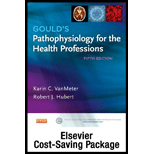
Pathophysiology Online for Gould's Pathophysiology for the Health Professions (Access Code and Textbook Package), 5e
5th Edition
ISBN: 9780323241007
Author: Karin C. VanMeter PhD, Robert J Hubert BS
Publisher: Saunders
expand_more
expand_more
format_list_bulleted
Concept explainers
Question
Chapter 8, Problem 1LO
Summary Introduction
To describe: The common skin lesions.
Concept introduction: The skin is the outer protective covering of the body. It is the largest organ of the body. The skin and its accessory components such as hair, nails, and glands make up the integumentary system of the body. A lesion is an area of abnormal growth or appearance found anywhere on or in the body. It may be caused by the systematic disorder and localized factors such as exposure to the toxins.
Expert Solution & Answer
Explanation of Solution
The common types of lesions are given as below:
- 1. Macule: Macule is a small, flat circumscribed area that is different in the color than the normal color. It is less than 1cm in diameter. For example, freckles, petechiae, measles, flat moles, and scarlet fever.
- 2. Nodule: Nodule is an elevated, palpable, firm circumscribed lesion. It is 1 to 2 cm in diameter. For example, lipomas, and erythema nodosum.
- 3. Papule: Papule is an elevated small, firm, circumscribed lesion. It is less than 1cm in diameter. For example, wart, elevated moles, fibroma, lichen planus, and insect bite.
- 4. Pustule: A pustule is an elevated, erythematosus lesion. It is less than 1cm in diameter. For example, impetigo, and acne.
- 5. Vesicle: Vesicle is an elevated, circumscribed, superficial, thin-walled lesion. It is filled with serous fluid. It is less than 1cm in diameter. For example, chickenpox, shingles, and herpes simpler.
- 6. Plaque: Plaque is a large, slightly elevated, and rough lesion with the flat top surface. It is greater than 1cm in diameter.
- 7. Ulcer: Ulcer is a cavity with a loss of epidermis and dermis. It is concave in shape and varies in size. For example, pressure ulcer, and stasis ulcer.
- 8. Fissure: Fissure is a small, deep linear break, or crack from the epidermis to dermis in the skin. It may be moist or dry. For example, athlete’s foot, anal fissure, cracks at the corner, and dermatitis.
Want to see more full solutions like this?
Subscribe now to access step-by-step solutions to millions of textbook problems written by subject matter experts!
Chapter 8 Solutions
Pathophysiology Online for Gould's Pathophysiology for the Health Professions (Access Code and Textbook Package), 5e
Ch. 8 - Prob. 1LOCh. 8 - Prob. 2LOCh. 8 - Prob. 3LOCh. 8 - Prob. 4LOCh. 8 - Prob. 5LOCh. 8 - Prob. 6LOCh. 8 - Prob. 7LOCh. 8 - Prob. 8LOCh. 8 - Prob. 9LOCh. 8 - Prob. 10LO
Ch. 8 - Prob. 8.1AYKCh. 8 - Prob. 8.1ATACh. 8 - Prob. 8.1BTACh. 8 - Prob. 8.1CTACh. 8 - Prob. 8.1DTACh. 8 - Prob. 8.2ATACh. 8 - Prob. 8.2BTACh. 8 - Prob. 8.2CTACh. 8 - Prob. 8.2DTACh. 8 - Prob. 8.3ATACh. 8 - Prob. 8.3BTACh. 8 - Prob. 8.3CTACh. 8 - Prob. 8.3DTACh. 8 - Prob. 8.3ETACh. 8 - Prob. 8.4ATACh. 8 - Prob. 8.4BTACh. 8 - Prob. 8.4CTACh. 8 - Prob. 8.4DTACh. 8 - Prob. 8.5ATACh. 8 - Prob. 8.5BTACh. 8 - Prob. 8.5CTACh. 8 - Prob. 8.5DTACh. 8 - Prob. 8.5ETACh. 8 - Prob. 1CSACh. 8 - Prob. 2CSACh. 8 - Prob. 3CSACh. 8 - Prob. 4CSACh. 8 - Prob. 5CSACh. 8 - Prob. 1CSBCh. 8 - Prob. 2CSBCh. 8 - Prob. 3CSBCh. 8 - Prob. 1SQCh. 8 - Prob. 2SQCh. 8 - Prob. 3SQCh. 8 - Prob. 4SQCh. 8 - Prob. 5SQCh. 8 - Prob. 6SQCh. 8 - Prob. 7SQCh. 8 - Prob. 8SQCh. 8 - Prob. 9SQCh. 8 - Prob. 10SQCh. 8 - Prob. 11SQCh. 8 - Prob. 12SQCh. 8 - Prob. 13SQCh. 8 - Prob. 14SQ
Knowledge Booster
Learn more about
Need a deep-dive on the concept behind this application? Look no further. Learn more about this topic, nursing and related others by exploring similar questions and additional content below.Recommended textbooks for you
 Phlebotomy EssentialsNursingISBN:9781451194524Author:Ruth McCall, Cathee M. Tankersley MT(ASCP)Publisher:JONES+BARTLETT PUBLISHERS, INC.
Phlebotomy EssentialsNursingISBN:9781451194524Author:Ruth McCall, Cathee M. Tankersley MT(ASCP)Publisher:JONES+BARTLETT PUBLISHERS, INC. Gould's Pathophysiology for the Health Profession...NursingISBN:9780323414425Author:Robert J Hubert BSPublisher:Saunders
Gould's Pathophysiology for the Health Profession...NursingISBN:9780323414425Author:Robert J Hubert BSPublisher:Saunders Fundamentals Of NursingNursingISBN:9781496362179Author:Taylor, Carol (carol R.), LYNN, Pamela (pamela Barbara), Bartlett, Jennifer L.Publisher:Wolters Kluwer,
Fundamentals Of NursingNursingISBN:9781496362179Author:Taylor, Carol (carol R.), LYNN, Pamela (pamela Barbara), Bartlett, Jennifer L.Publisher:Wolters Kluwer, Fundamentals of Nursing, 9eNursingISBN:9780323327404Author:Patricia A. Potter RN MSN PhD FAAN, Anne Griffin Perry RN EdD FAAN, Patricia Stockert RN BSN MS PhD, Amy Hall RN BSN MS PhD CNEPublisher:Elsevier Science
Fundamentals of Nursing, 9eNursingISBN:9780323327404Author:Patricia A. Potter RN MSN PhD FAAN, Anne Griffin Perry RN EdD FAAN, Patricia Stockert RN BSN MS PhD, Amy Hall RN BSN MS PhD CNEPublisher:Elsevier Science Study Guide for Gould's Pathophysiology for the H...NursingISBN:9780323414142Author:Hubert BS, Robert J; VanMeter PhD, Karin C.Publisher:Saunders
Study Guide for Gould's Pathophysiology for the H...NursingISBN:9780323414142Author:Hubert BS, Robert J; VanMeter PhD, Karin C.Publisher:Saunders Issues and Ethics in the Helping Professions (Min...NursingISBN:9781337406291Author:Gerald Corey, Marianne Schneider Corey, Cindy CoreyPublisher:Cengage Learning
Issues and Ethics in the Helping Professions (Min...NursingISBN:9781337406291Author:Gerald Corey, Marianne Schneider Corey, Cindy CoreyPublisher:Cengage Learning

Phlebotomy Essentials
Nursing
ISBN:9781451194524
Author:Ruth McCall, Cathee M. Tankersley MT(ASCP)
Publisher:JONES+BARTLETT PUBLISHERS, INC.

Gould's Pathophysiology for the Health Profession...
Nursing
ISBN:9780323414425
Author:Robert J Hubert BS
Publisher:Saunders

Fundamentals Of Nursing
Nursing
ISBN:9781496362179
Author:Taylor, Carol (carol R.), LYNN, Pamela (pamela Barbara), Bartlett, Jennifer L.
Publisher:Wolters Kluwer,

Fundamentals of Nursing, 9e
Nursing
ISBN:9780323327404
Author:Patricia A. Potter RN MSN PhD FAAN, Anne Griffin Perry RN EdD FAAN, Patricia Stockert RN BSN MS PhD, Amy Hall RN BSN MS PhD CNE
Publisher:Elsevier Science

Study Guide for Gould's Pathophysiology for the H...
Nursing
ISBN:9780323414142
Author:Hubert BS, Robert J; VanMeter PhD, Karin C.
Publisher:Saunders

Issues and Ethics in the Helping Professions (Min...
Nursing
ISBN:9781337406291
Author:Gerald Corey, Marianne Schneider Corey, Cindy Corey
Publisher:Cengage Learning